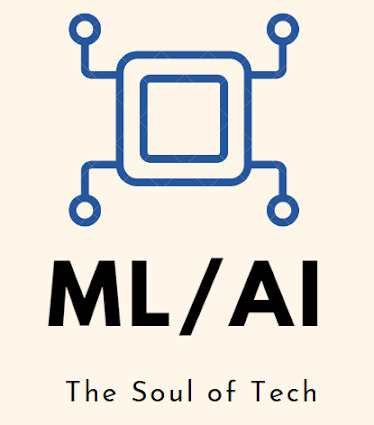About
What
is ML?
Machine Learning (ML) is defined as follows: A code learns from
experience E with respect to a task T and a performance measure P, if its performance
on T, as measured by P, improves with E. [1].
Example 1: your code monitors spam and classifies emails as spam or not
spam (SNS). In this case, T = classifying emails as SNS; E = watching you label
emails as SNS; P = the fraction of emails correctly classified as SNS.
Example 2: playing checkers. E = the
experience of playing many games of checkers; T = the task of playing checkers;
P = the probability that the program will win the next game.
ML is a part of Artificial Intelligence (AI). ML algorithms build a model based on sample data, known as training
data, in order to make predictions or decisions without being explicitly
programmed to do so [2]. ML is an important subset of data science. Through the
use of statistical methods, data science algorithms are trained to make
classifications or predictions, uncovering key insights within data mining
projects. These insights subsequently drive decision making within applications
and businesses, ideally impacting key BI/fintech metrics.
Bottom Line: ML is the science of getting computers to
learn, without being explicitly programmed.
Why ML?
Modern
businesses across almost all sectors use various machine learning technologies
[4]: logistics, manufacturing, hospitality, travel/tourism, energy, and
utilities. As an example, the healthcare industry is utilizing ML to achieve
more accurate diagnoses. Retailers also use ML to send the right goods and
products to the right stores before it is out of stock. The top ML applications
are chatbots as virtual assistants or VA, BI-type decision support, customer
recommendation and churn engines, demand pricing, market research, fraud
detection, computer vision (CV), operational efficiencies via DevSecOps known
as MLOps, and text data analysis via natural language processing (NLP). Very
successful ML use cases deal with database mining by analyzing large datasets
such as web click data, medical records, etc. Industry-4 IoT devices can also
perform ML tasks. Today most innovation-oriented companies are looking for ways
to make their brand stand out in the marketplace.
ML
Tech/Ops
Your ML journey begins with
the most fundamental question:
Here DA means Data Analytics
that consists of descriptive, diagnostic (such as Hypothesis, Conjectures and
Assumptions), predictive and prescriptive algorithms [5]. Descriptive DA includes Trends, Averages,
STD, Box Plots, X-Plots, Hist, etc. Predictive DA is based upon the Regression
Analysis and Logistical Regression. Prescriptive DA is designed for Decision
Making (Concept of Probability).
In contrast, ML implies
unsupervised, supervised, reinforcement and deep learning algorithms [3]. Unsupervised ML
deals with Untrained Data Mining
(Classification, Regression
and K-means Clustering as implemented in scikit-learn [6]). With Anaconda’s
platform [7], you can build and deploy deep learning (DL) algorithms that use
neural networks. Anaconda easily integrates with tools like TensorFlow,
pyTorch, mxnet and Keras [8] so you can build and train neural network models,
including convolutional neural networks (CNNs) and generative adversarial
networks (GANs). Reinforcement
learning (RL) such as Q-learning or SARSA is an area of ML concerned with how intelligent agents ought to
take actions in an environment in order to maximize the notion of cumulative
reward [9]. The free Mathworks RL onramp [10] provides a vivid introduction to
RL for control problems.
Key Takeaways
ML: parse data, learn
from that data, and make informed decisions based on what it has learned.
DL: create NN layers
that can learn and make intelligent decisions on its own (e.g. via
backpropagation loop).
In fact, most SMEs these days use public cloud computing web services to use ML for a fee so
that they can focus on their core business rather than building on-premise ML
infrastructure. The AWS ML API’s such as Sagemaker and Rekognition enable data
scientists and MLOps engineers to build, train, test and deploy ML models for
various use cases [11]. The Azure ML Studio accelerates time to value with
industry-leading MLOps, open-source interoperability, and integrated tools such
as DevOps Boards [12]. In addition, you can use
the GCP AI Platform to train your ML models at scale, to host your trained
model in the cloud, and to use your model to make predictions about new data
[13].
ML
Use Cases
AWS ML services [11] explore a
variety of common use cases such as intelligent contact centers,
personalization, automated document processing, search Kendra, fraud detection,
business metrics and media content analysis. The
Azure ML is helping retail and consumer brands improve the shopping experience
by ensuring shelves are stocked and product is always available when, where and
how the consumer wants to shop [12]. The top three GCP ML use cases are as
follows: predicting high value
start-up investment, predicting maintenance jobs on an oil rig, and real-time
predicted relevant ads for customers in taxis.
References
[1] Mitchell, T., 1997,
Machine learning, McGraw Hill.
[2] https://en.wikipedia.org/wiki/Machine_learning
[3] https://www.ibm.com/cloud/learn/machine-learning
[4] https://www.techfunnel.com/information-technology/machine-learning-business-applications/
[5] https://www.investopedia.com/terms/d/data-analytics.asp
[6] https://scikit-learn.org/stable/
[7] https://www.anaconda.com/use-cases
[8] https://towardsdatascience.com/best-python-libraries-for-machine-learning-and-deep-learning
[9] https://en.wikipedia.org/wiki/Reinforcement_learning
[10] https://www.mathworks.com/learn/tutorials/reinforcement-learning-onramp.html
[11] https://aws.amazon.com/machine-learning/
[12] https://azure.microsoft.com/en-us/services/machine-learning/
[13] https://cloud.google.com/ai-platform/docs/technical-overview



Comments
Post a Comment